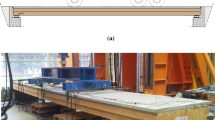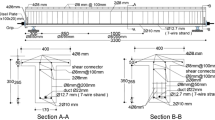Abstract
The paper reports the results of a comprehensive experimental test performed on a 6 m span timber-concrete composite beam with glued re-bar connection. The beam had first been subjected to sustained load in unsheltered outdoor conditions for 5 years. Eventually a ramp loading test up to failure was performed. The long-term test showed an increase in deflection mainly during the first two years, while the slip rose during the whole testing period. Thermo-hygrometric variations of environment caused an important fluctuation of all quantities on both yearly and daily scale. By comparing experimental and analytical results, it is highlighted that composite beams in outdoor conditions should be assigned to the 3rd service class according to the Eurocode 5 (EC5). Analytical predictions based on approximate formulae suggested by such regulation are found to be not conservative for the long-term behaviour and fairly accurate for the collapse behaviour. Since the simplified formulae proposed by the latest versions of the EC5-Parts 1.1 and 2 largely underestimate the actual connection stiffness and strength, it is recommended that realistic values of these properties, such as those obtained through push-out tests, be used when designing timber-concrete composite beams.
Similar content being viewed by others
References
Ceccotti A (1995) Timber-Concrete Composite Structures, Timber Engineering, Step 2, 1st Edn. (Centrum Hout, The Netherlands) E13/1-E13/12.
Comité Européen de Normalisation, Eurocode 5 (2003) – Design of timber structures – Part 1-1: General - Common rules and rules for buildings, Final Draft, prEN 1995-1-1 (Bruxelles, Belgium).
Comité Européen de Normalisation (1996) Eurocode 5 – Design of Timber Structures – Part 2: Bridges, ENV 1995-2 (Bruxelles, Belgium).
Piazza M, Ballerini M (2000) Experimental and numerical results on timber-concrete composite floors with different connection systems, in ‘6th WCTE,’ Proceedings of the World Conference on Timber Engineering, Whistler Resort, British Columbia, Canada, CD.
Steinberg E, Selle R, Faust T (2003) Connectors for timber-lightweight concrete composite structures. J. of Struct. Eng., 129(11):1538–1545.
Comité Euro-International du Béton (1993) CEB Bull. No 213/214: CEB-FIP Model Code 90’ (Lausanne, Switzerland).
Ranta Maunus A (1975) The viscoelasticity of wood at varying moisture content, Wood Science and Tech. 9:189–205.
Toratti T (1992) Creep of timber beams in a variable environment: Report 31 (Lab. of Struct. Eng. and Build. Physics, Helsinki Univ. of Technology, Finland).
Hanhijärvi A (2000) Advances in the knowledge of the influence of moisture changes on the long-term mechanical performance of timber structures, Mater. Struct. 33:43–49.
Kenel A, Meierhofer U (1998) Long term performance of timber concrete composite structural elements, Report No. 115/39 (EMPA Abteilung Holz, Dübendorf), only available in German.
Amadio C, Ceccotti A, Di Marco R, Fragiacomo M (2001) Long-term behaviour of a timber-concrete connection system, in ‘Joints in Timber Structures’, Proceedings of the RILEM Symposium, Stuttgart, Germany, 263–272.
Mungwa MS, Kenmou DA (1993) Istantaneous and time-dependent analysis of composite wood-concrete cross-sections using Dischinger's equations of state: Part 1 – Istantaneous analysis; Part 2 – Time dependent analysis. Mater. Struct., 26:98–102, 176–180.
Fragiacomo M (2005) A finite element model for long-term analysis of timber-concrete composite beams. Struct. Eng. & Mechanics, 20(2):173–189.
Schänzlin J (2003) About the time dependent behaviour of composite of board stacks and concrete. Ph.D. Thesis (Univ. of Stuttgart), only available in German.
Grantham R, Enjily V, Fragiacomo M, Nogarol C, Zidaric I, Amadio C (2004) Potential upgrade of timber frame buildings in the UK using timber-concrete composites, in ‘8th WCTE’, Proceedings of the World Conference on Timber Engineering. Lahti, Finland, 2:59–64.
Bou Saïd E, Jullien J-F, Ceccotti A (2004) Long term modelling of timber-concrete composite structures in variable climates, in ‘8th WCTE’, Proceedings of the World Conference on Timber Engineering. Lahti, Finland, 2:143–148.
Capozucca R (1998) Bond stress system of composite concrete-timber beams. Mater. Struct., 31:634–640.
Gutkowski RM, Brown K, Shigidi A, Natterer J (2004) Investigation of notched composite wood-concrete connections. J. Struct. Eng., 130(10):1553–1561.
Capretti S, Ceccotti A (1996) Service behaviour of timber-concrete composite beams: a 5-year monitoring and testing experience, in Proceedings of the World Conference on Timber Engineering, New Orleans, USA, 3:443–449.
CEN/TC124 Structural timber (1998) Work Group 2, prEN 1194: Timber structures – Glued laminated timber – Strength classes and determination of characteristic values.
Fragiacomo M, Ceccotti A (2006) Long-term behavior of timber-concrete composite beams. I: Finite element modeling and validation. J. Struct. Eng., 132(1):13–22.
Fragiacomo M (2006) Long-term behavior of timber-concrete composite beams. II: Numerical analysis and simplified evaluation. J. Struct. Eng., 132(1):23–33.
Turrini G, Piazza M (1983) A technique for stiffness and strength upgrading of wooden floors. Recuperare 5:224–237, only available in Italian.
Comité Européen de Normalisation (1993) Eurocode 5 – Design of timber structures – Part 1-1: General - Common rules and rules for buildings, Final Draft, ENV 1995-1-1 (Bruxelles, Belgium).
Author information
Authors and Affiliations
Rights and permissions
About this article
Cite this article
Ceccotti, A., Fragiacomo, M. & Giordano, S. Long-term and collapse tests on a timber-concrete composite beam with glued-in connection. Mater Struct 40, 15–25 (2007). https://doi.org/10.1617/s11527-006-9094-z
Received:
Accepted:
Published:
Issue Date:
DOI: https://doi.org/10.1617/s11527-006-9094-z




